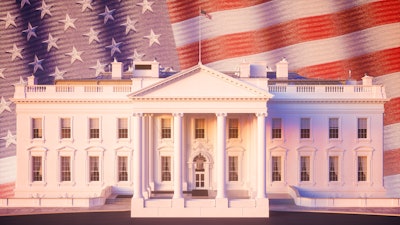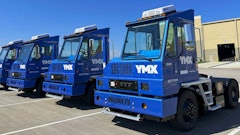
Supply chain experts are contemplating what it means to have the Trump administration come on board in 2025 and how it will shape the supply chain outlook.
“There are many broad and sweeping agenda items President-elect Trump has put forth, but it is difficult to put them into a context that we can quantify until we get many more specifics around timing and actual implementation details,” says Jonathan Starks, CEO of FTR Transportation Intelligence. “International supply chains – which is nearly every supply chain at this point – will need to be prepared for some significant developments as they relate to imports and demand. There are some potential positives for overall demand, but we view them as relatively limited in scope and potentially undone if inflation does not remain contained.”
Many of the core factors impacting a U.S. domestic manufacturing base will continue, says Ross Meyercord, CEO of Propel Software.
“I may be a little bit of an outlier here, but I do not think there is going to be dramatic changes, at least in the near- to mid-term. The things the Trump administration has stated that they want to focus on like investing in domestic manufacturing, lessening our dependence on China, increasing energy independence – all of these types of initiatives are really to one degree or another continuation of policies that either Trump started and Biden continued, or new initiatives that Biden initiated,” says Meyercord. “One thing that is for certain, though, is that we will see a market decrease in regulations which for a lot of companies should open up their ability to more rapidly implement change, to increase capacity, to make various changes to how they're thinking about their supply chain.”
There is more salience in the realm of international trade.
“Broad tariffs would create a significant pull forward of inventories and a subsequent long-term reduction in import levels or a notable increase in costs,” Starks says. “We saw this in 2017-2018 when tariffs went into effect on a more limited basis. One of the stated upsides is that it would drive more re-shoring activity, but we do not view that as a realistic driver of U.S. growth in 2025 or 2026.”
Meyercord concurred with other supply chain experts with respect to the proposed tariffs, “there are a lot of details we are all still waiting for to sort this out, but it does appear there will be for sure very high tariffs assessed on Chinese imports and to some degree additional tariffs on the rest of the world.”
“They’re really likely to continue to accelerate some of the changes I've been seeing across global supply chains and a couple of these are decreased goods imported from China,” he adds.
That is nothing new from the manufacturers.
“Since COVID, they’ve been focused on this,” he adds. “I think we're going to see that accelerate with folks looking at alternative markets in Southeast Asia, areas like the Indian subcontinent, Vietnam and others.”
There will be more nearshoring with companies looking to locations like Mexico, Central America and the Caribbean, and domestic manufacturing being obvious, Meyercord says.
“What’s really interesting about thinking about how tariffs will impact domestic manufacturing is that coupled with the likely changes on immigration, more domestic manufacturing presumably means you need more workers, but that coupled with a world in which immigration may become more difficult and we may look to remove some number of people who aren't here legally today, is going to cause a pressure on the existing regimen around tariffs,” Meyercord says. “One of these two policies has to bend, if not break, a bit to make this equation work. I would expect we’ll see a dramatic rise in visas and for legal immigration, particularly for skilled workers, to help fuel this boom going forward.”
“When President-elect Trump was previously in the Oval Office, we saw businesses move the origin cargo to other locations in Southeast Asia such as Vietnam,” notes Richard Fattal, co-founder and co-CEO at Zencargo. “Cargo also was routed to Mexico where companies did additional work on goods to claim that they were of Mexican origin, and then exported them to the U.S. under the NAFTA agreement.”
As a consequence, the United States may see legislation introduced that will attempt to make this activity more difficult to achieve, although it is tricky to enforce rules-of-origin legislation, Fattal says.
“In any case, this may be one of the workarounds we see from businesses and will be positive for Mexico,” he adds. “What President-elect Trump’s proposed tariffs will mean for transport is that in the short term, shippers are likely to frontload their goods before the tariffs are in place. In the medium term, the tariffs could reduce the amount of cargo moving from Asia – particularly China – to the U.S.”
In parallel, this may prompt an increase in trucking within the American domestic economy, and potentially between Mexico and the U.S., Fattal says.
“This is cause for some excitement for many involved with associated industries as the domestic transport market is still recovering from recession,” he adds. “There will be more demand for warehousing services, ground transportation, and intermodal services within the U.S. and less demand and reliance on the transpacific market.”
The trade war between the U.S. and China in 2018 also showed that the capability of Southeast Asia to absorb additional shipping is limited, Fattal adds.
“The region’s shipping infrastructure is less developed and more complicated to navigate, often relying on feeder services, making large-scale cargo movements challenging,” he adds. “By comparison, China-U.S. lanes are well-established trading routes and smoother passages for shippers. The 2018 trade war additionally led to a surge in spot rates, up by 70%, due to the front loading of cargo.”
Experts are also eyeballing the status of regulations and trade policies, workforce and wage laws, federal investments in transportation, global sanctions and sustainability regulations based on Donald Trump's positions.
Changes in regulations – including climate, workforce, and consumers – tend to be difficult to quickly change, or at least change significantly enough that they impact overall economic activity, Starks says.
“A trade war would be bad for growth, bad for supply chains, bad for consumers,” he adds.
Regarding sustainability regulations, Meyercord notes, “it appears that President-elect Trump really wants to de-emphasize – potentially dramatically – alternative energy, green energy, solar, wind, electric cars, etc. But from what I am hearing and seeing in the market, it really appears that consumers like a number of these initiatives. They like to be able to get cheap solar power. They like the opportunity to get wind power. There are varying degrees of electric and hybrid cars that are continuing to grow in the marketplace today.”
While it is very likely the subsidies will go away for these, the question is whether these green initiatives are able to now stand on their own two feet, says Meyercord.
“Do they have enough broad-based consumer demand out there that they can actually prosper and potentially thrive? Arguably not having government subsidies will force these industries to be ever more efficient and really understand what are the products that consumers want, not necessarily the products that the government is suggesting they build,” he adds. “[I believe in a] second wave of green tech, which is more consumer-driven than government policy-driven as we go forward.”
Meyercord contemplates this issue, thinking the ‘X’ factor in this situation is Elon Musk.
“Given that he makes so much of his money from solar and electric cars, and he's potentially going to be a very influential member if not advisor to the Cabinet, it’s possible that the rhetoric will downshift on green tech and I think we may see that as an area which frankly continues to thrive under Trump and is not negatively impacted,” he adds.
As for the impact on manufacturing, transportation, and warehousing sectors, “we see no specific impact on the transportation sector aside from the potential for larger swings in demand coming from the proposed tariff regime,” says Starks.
It comes back to the issue of whether the U.S. has enough skilled employees domestically to help support a revitalized domestic manufacturing base.
“Likely we won’t,” Meyercord says. “We will be capacity-constrained from a people side. I think we’ll see companies continue to invest heavily in automation, in AI and worker training programs and probably in visa-sponsored programs assuming those get approved to help get workers here to support the business or figure out how to continue to make products with fewer and fewer employees to support that. Given tariffs in the big scheme of things are relatively easy to turn on and turn off – and we’ve seen that historically – as companies think about their future in a world with a higher tariff regimen, my recommendation is they also think about what happens if those get added, changed, or deleted along the way. Will my business, will my product line, will my expansion plans still prosper if I don't have the protection of those tariffs? This notion of being very flexible and dynamic in your planning will be really important.”
In the short term, U.S. companies are likely to frontload imports to stock up ahead of potential new tariffs, says Anne Sophie Fribourg, vice-president of Global Ocean Freight at Zencargo.
"We know that one of the major challenges ahead of us is the U.S. election of Donald Trump, which will have a direct effect on global trade,” says Fribourg. “There will probably be quite a significant impact on trade, at least between Asia, particularly China and the U.S., but also from Europe to the U.S.”
In 2018, when President Trump raised the tariffs on some products, which was also continued by the Biden administration, “the Chinese proportion of U.S. imports from China dropped from 40% in 2016 to 27% in 2022, so we've already seen that there's been a restriction on the volume of imports,” says Fribourg. “Donald Trump this time has committed to the electorate to call out 60% customs tariffs on China and about 20% on other countries. He will probably do part of this and that will have an impact, but people have already started to look at ways to move cargo from countries other than China.”
Vietnam is a country getting more cargo, and Mexico is one of the major countries where people will see the impact of a diversion of sourcing to Southeast Asia, according to Fribourg.
“We at Zencargo are also talking about India, though India is a difficult country to operate in,” she says. “But talking about Southeast Asia, this is a good opportunity. We see that shipping lines are investing in the routes. They are adding bigger ships, but the routes that are still are not the same as the routes from China. It's not as easy as with China as there are still some feeders in Southeast Asia and the Southeast Asian routes are a bit more complicated and will take time to become more prominent. We say that China is the world's factory, so it will be a good number of years before other countries can replace China, and so we still have some good business coming from there.”
Regarding Mexico, Fribourg notes there could be an increase in volumes going via Mexico to the U.S., and one of the impacts would be less demand from trade and more demand on the domestic U.S. market, “which is quite good in a way because the domestic market has been in recession. These are the impacts that I foresee for the coming year and coming months."
Meyercord sat in on a bipartisan symposium with members of the U.S. House and Senate in 2023 before the presidential election cycle started “and a lot of the discussion was around domestic prosperity and a broad economic outlook for the U.S. What really struck me is this topic of having a strong industrial base in America that is supported by advanced manufacturing where we can continue to make our high technology products,” he says. “That we have the know-how to make them domestically was probably the most bipartisan agreed-upon topic. This notion of how to make the U.S. a very self-sufficient and strong manufacturing base is a universally accepted notion that it's a good idea.”
Meyercord notes people differ on the policies to support that notion.
“But at a fundamental basis, I was really heartened to see there was really no partisan divide on this topic,” he says. “Everyone agreed this is the right outcome. We need, of course, to haggle on policy to get that outcome. But I was encouraged that this is something I think that can work its way through politics and ultimately end up in policy as we move forward.”
According to a Zencargo poll, 55% of the respondents indicated geopolitical concerns topped the list, followed by a tie of carrier behavior and port congestion/labor issues for 18% of the respondents. For 9%, the global economy was the primary concern.
No one chose the option of black swan/extreme climate events or regulatory/environmental, social and governance.
Zencargo notes the geopolitical situation to have a high level of uncertainty with a medium level of disruption impact on major trade routes, based on the ongoing Red Sea Crisis and other geopolitical tensions such as U.S. trade tariffs on China and China-Taiwan tensions.
Fribourg indicates in 2024, protests, labor strikes, climate events such as low water levels in canals are all disruptions “created by external events that are showing us the importance of the remaining agile and resilient and the importance of being able to secure alternative routes, secured routes, and also planning the supply chain needs well ahead.”
Meyercord concurs, saying one lesson learned during the COVID-19 pandemic is that everyone has to focus on supply chain resilience.
“All of the companies I’ve talked to have really taken that to heart,” he adds. “There’s this idea of ‘how can I become more and more nimble? I would suggest that going forward, people need to double down on their nimbleness, because it's quite likely that trade policies and how those impact our supply chains will be ever more dynamic, probably less predictable. Being on your toes on what you are doing today and what you need to pivot to tomorrow will be a key mark of success for companies as they move forward.”

















